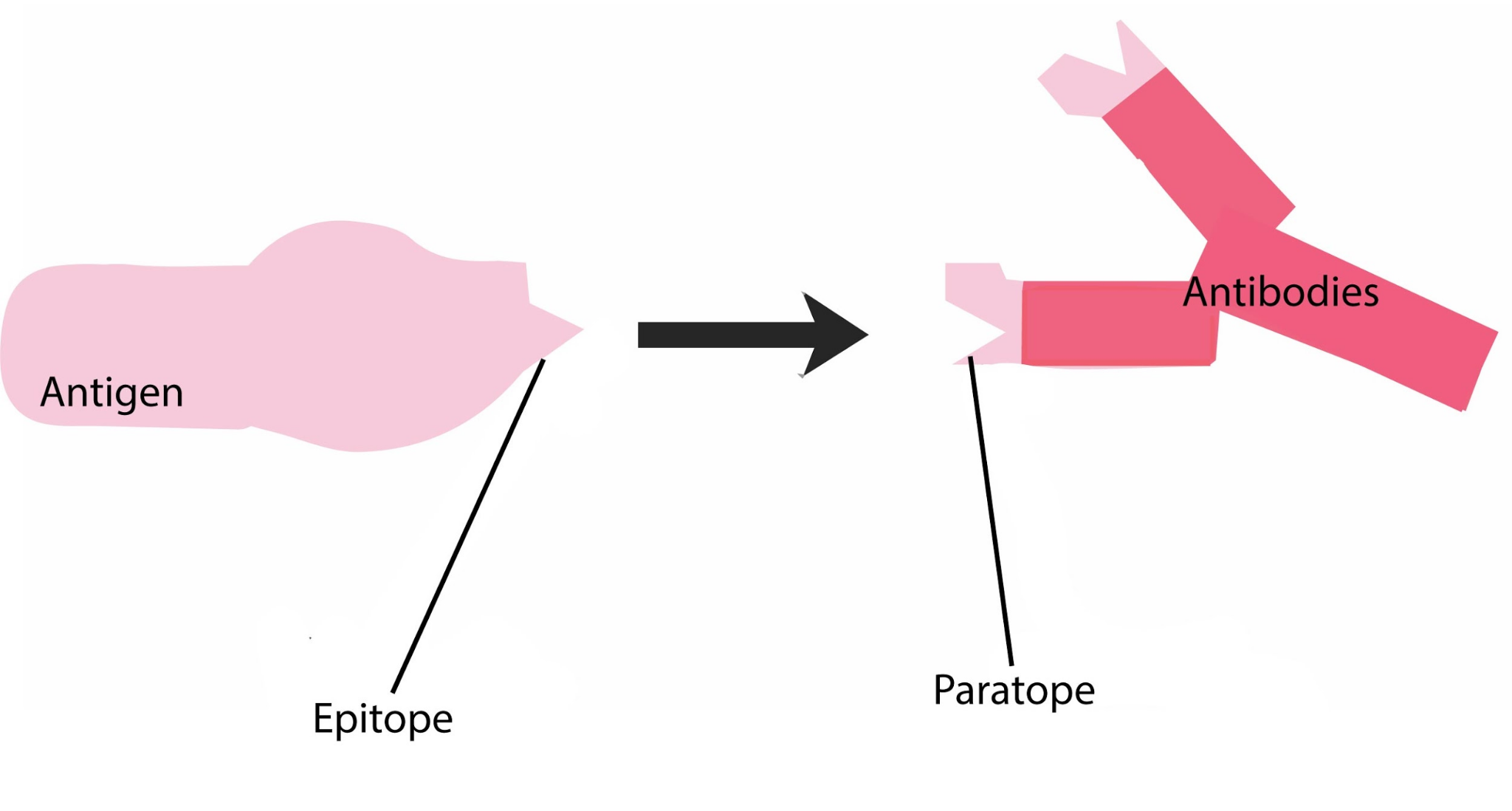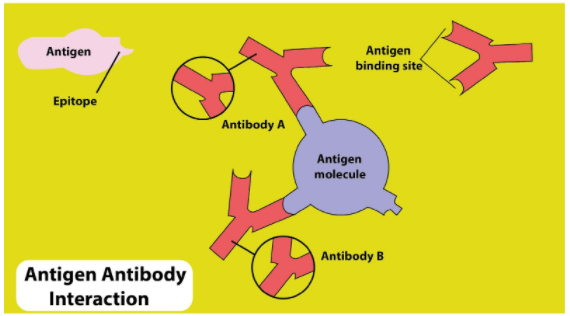Antigen-Antibody Reaction
Antigen-antibody reaction is a fundamental process of the immune system in which specific proteins called antibodies bind to foreign substances termed antigens. This reaction protects our bodies by either neutralising or eliminating harmful agents such as viruses, bacteria, and toxins. In antigen-antibody reactions in microbiology, these interactions are widely used for diagnostic tests and research. Below, we will explore the detailed mechanism, properties, and antigen-antibody reaction types, along with unique insights and examples.

What is an Antigen?
An antigen is any substance (usually foreign to the body) that triggers an immune response. It can be a protein, polysaccharide, lipid, or other molecule capable of being recognised by the immune system. A specific region on the antigen to which an antibody binds is called the epitope.
Key Points
Antigens can be immunogens (capable of eliciting an immune response on their own) or haptens (require a carrier molecule to trigger an immune response).
Common antigenic components include viral coats, bacterial cell walls, toxins, and surface proteins.
Autoantigens are the body’s components, sometimes mistakenly targeted by the immune system (as seen in autoimmune disorders).
What is an Antibody?
An antibody (also called immunoglobulin) is a Y-shaped glycoprotein produced by specialised white blood cells known as B lymphocytes (or B-cells). These antibodies specifically recognise and bind to antigens.
Key Points
Five major classes: IgG, IgA, IgM, IgE, and IgD (a quick mnemonic is “GAMED”).
Each antibody has a unique paratope, which binds to the epitope of an antigen.
Primarily generated by activated B-cells (plasma cells).
Antigen-Antibody Reaction Mechanism
Antigen-antibody reaction is also known as the Ag-Ab reaction or serological reaction. It follows a three-stage mechanism:
Formation of the Ag-Ab Complex:
The antigen fits into the antibody’s binding site much like a key in a lock.
This step is highly specific and depends on the precise molecular structure of both antigen and antibody.
Visible Manifestation:
After binding, certain reactions become visibly apparent such as precipitation, agglutination, or colour change (in assays like ELISA).
Elimination or Neutralisation of the Antigen:
The antigen is then neutralised, lysed, or removed by various immune processes (e.g., phagocytosis).

Properties of Antigen-Antibody Reaction
Specificity: Each antibody binds only with the antigen that matches its paratope.
Reversibility: The bonds are non-covalent (e.g., ionic bonds, hydrogen bonds, hydrophobic interactions).
Affinity: Strength of binding between a single epitope and a paratope.
Avidity: Overall strength of binding when an antibody with multiple binding sites interacts with an antigen with multiple epitopes.
Cross-Reactivity: An antibody may bind to antigens with similar epitopes.
Types of Antigen-Antibody Reaction
When you study antigen-antibody reaction notes, you will frequently encounter these antigen-antibody reaction types:
Precipitation Reaction
Occurs when a soluble antigen combines with its specific antibody in the presence of electrolytes at an optimal pH and temperature, forming an insoluble precipitate.
Liquid Precipitation: Varying amounts of antigen are added to a fixed amount of antibody to see where visible precipitate forms.
Gel Precipitation: Antigen and antibody diffuse in a gel medium (like agar), forming precipitation lines where they meet in optimal proportions.
Agglutination Reaction
Involves the clumping (agglutination) of particulate antigens (e.g., RBCs, bacterial cells) by their specific antibodies.
Slide Agglutination: Quick test to check for agglutinating antibodies.
Tube Agglutination: Used to determine antibody titre by serial dilution.
Passive Agglutination: Converts a precipitation reaction into an agglutination reaction by coating soluble antigens onto carrier particles such as latex beads or RBCs.
Antigen-antibody reaction example here is the Widal test for diagnosing typhoid fever.
Complement Fixation
The complement system (a group of proteins) is activated when an antigen-antibody complex forms, leading to lysis of cells or microbes.
Principle: If the antibody is present, it binds the antigen and “fixes” the complement, preventing it from lysing indicator RBCs used in the test.
Immunofluorescence
Antibodies are labelled with fluorescent dyes (e.g., fluorescein) that emit visible light upon exposure to UV light.
Useful for locating or identifying antigens in cells or tissues under a fluorescence microscope.
ELISA (Enzyme-Linked Immunosorbent Assay)
Detects and measures antibodies or antigens in a sample using enzyme-linked markers.
Indirect ELISA: Often used to detect antibodies (e.g., in HIV testing).
Sandwich ELISA: Detects an antigen in a sample by “sandwiching” it between two specific antibodies.
Competitive ELISA: Measures antigen concentration by observing competition between labelled and unlabelled antigens for binding sites on the antibody.
Also Read: ELISA
Antigen-Antibody Reaction in Microbiology
In microbiology, these reactions are crucial for diagnosing infectious diseases. Examples include:
Widal Test: Detects antibodies against Salmonella typhi.
VDRL Test: Used for syphilis detection.
ASO Test: Detects antibodies against Streptococcal bacteria.
These tests highlight how antigen-antibody reaction in microbiology helps identify specific infections quickly and accurately.
Mnemonic for Immunoglobulin Classes
A quick mnemonic to remember the five major antibody (immunoglobulin) classes is GAMED:
G – IgG
A – IgA
M – IgM
E – IgE
D – IgD
Quick Quiz (with Answers)
Which of the following immunoglobulins is the most abundant in human serum?
a) IgM
b) IgG
c) IgA
d) IgEAnswer: b) IgG
What is the specific name of the region on an antigen that binds to an antibody?
a) Paratope
b) Hapten
c) Epitope
d) None of the aboveAnswer: c) Epitope
Which of the following techniques uses enzymes attached to the antibody for detection?
a) Western Blot
b) ELISA
c) Immunofluorescence
d) Complement FixationAnswer: b) ELISA
Antigen-antibody reaction is also known as…
a) Immuno-coagulation
b) Serological reaction
c) Haemolysis
d) Complement cascadeAnswer: b) Serological reaction
Key Takeaways
Antigens are foreign substances that prompt an immune response, while antibodies are specialised proteins that bind to these antigens.
The antigen-antibody reaction involves a three-step process: formation of the complex, visible manifestation (e.g., agglutination), and elimination or neutralisation.
Important antigen-antibody reaction types include precipitation, agglutination, complement fixation, immunofluorescence, and ELISA.
These reactions are pivotal in diagnostic tests in antigen-antibody reactions in microbiology and play a major role in protecting the body against pathogens.
Related Topics


FAQs on Antigen-Antibody Reaction: Definition, Types and Examples
1. What is the significance of antigen-antibody reactions in disease diagnosis?
Antigen-antibody reactions help detect the presence of specific pathogens (bacteria, viruses, etc.) through tests like ELISA, Widal, and VDRL. By identifying the antibodies produced by the body, clinicians can determine if a person has been infected.
2. Can one antibody bind to multiple antigens?
Generally, an antibody binds most strongly to a specific antigenic epitope. However, if different antigens share similar epitopes (cross-reactivity), one antibody can occasionally bind to more than one antigen.
3. Why are antigen-antibody bonds reversible?
They rely on non-covalent forces (such as hydrogen bonds, ionic bonds, and hydrophobic interactions). These forces can be formed or broken depending on conditions like pH, temperature, or ionic strength.
4. How do agglutination reactions differ from precipitation reactions?
Agglutination involves the clumping of particulate (insoluble) antigens, such as cells or latex beads. Precipitation involves soluble antigens that form an insoluble precipitate when bound to their specific antibodies.
5. Is the complement system always required for an antigen-antibody reaction?
Not always. While the complement system enhances the lysis of pathogens, some antigen-antibody interactions (like neutralisation of toxins) do not necessarily involve complement.










